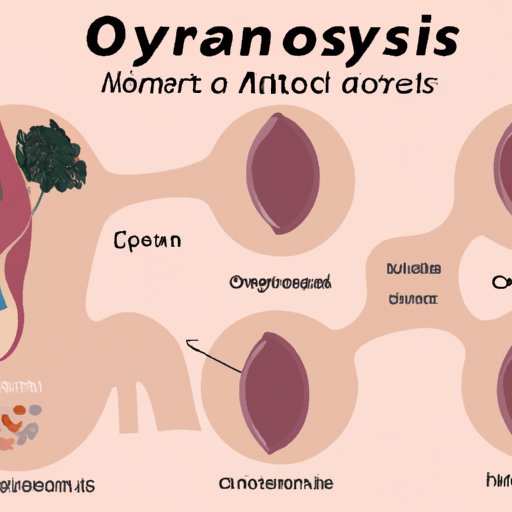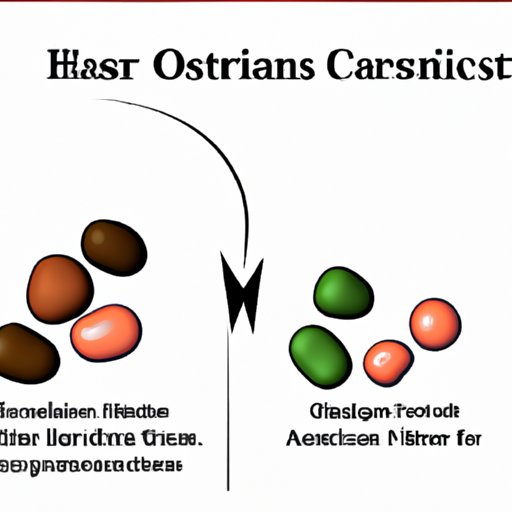
Introduction
Ovarian cysts are fluid-filled sacs that develop on the ovaries, which are part of the female reproductive system. Most women will develop at least one cyst at some point in their life, but they often go away on their own and are typically harmless. However, some cysts can cause pain and other complications and require medical attention. This article will explore the different causes of ovarian cysts, the role of hormonal imbalances and genetics in their development, the link between endometriosis and cysts, the impact of dietary habits on ovarian cyst formation, and the importance of early detection through regular gynecological checkups.
Understanding the Causes of Ovarian Cysts
Ovarian cysts are a common condition that can develop for a variety of reasons. They can be small or large, single or multiple, and sometimes they can even grow to several inches in diameter. Most ovarian cysts are benign, meaning they are not cancerous, and occur as part of the normal menstrual cycle.
Follicle Cysts
Follicle cysts are the most common type and usually form during ovulation, when the ovaries release an egg. In a normal cycle, a sac called a follicle grows on the ovaries in preparation for ovulation. The egg is released from the follicle and, if not fertilized, the follicle normally dissolves. However, when the follicle fails to break open and release the egg, it can continue to grow and develop into a cyst.
Corpus Luteum Cysts
Corpus luteum cysts form after the release of the egg from the follicle when the empty follicle sac seals off. This sac then begins producing progesterone and forms a structure called the corpus luteum. In some cases, the corpus luteum can fill up with fluid, causing a cyst to form.
Endometriomas
Endometriomas, also called chocolate cysts, form when tissue that usually grows inside the uterus grows outside of it, such as on the ovaries. This misplaced tissue responds to hormones and can form cysts.
Cystadenomas
Cystadenomas are cysts that form from cells on the outer surface of the ovary and can contain either fluid or mucus. These are typically noncancerous but can become very large and cause pain or discomfort.
The Correlation Between Hormonal Imbalances and Ovarian Cyst Formation
Hormones play a vital role in the development of ovarian cysts. Ovarian cysts are often associated with hormonal imbalances that affect the normal functioning of the ovaries. The ovaries produce a range of hormones, including estrogen and progesterone. When these hormones are not produced in the right amounts, it can cause ovarian cysts to form.
Explanation of Hormones Involved in Ovarian Cyst Development
Estrogen and progesterone are hormones that regulate the menstrual cycle. Estrogen is responsible for stimulating the growth of the endometrium, or the lining of the uterus, while progesterone prepares the uterus for possible pregnancy. When an egg is not released, the body’s natural hormonal balance can be disrupted, leading to the formation of cysts on the ovaries.
How Imbalances in Hormones Can Lead to Cyst Formation
If there is too much estrogen in the body, it can cause the lining of the uterus to become too thick. This can lead to heavier menstrual periods and an increased risk of endometrial cancer. If there is too much progesterone, it can cause the corpus luteum to grow excessively, leading to the formation of cysts. Hormonal imbalances can also cause irregular menstrual cycles, which can increase the risk of developing certain types of ovarian cysts.
The Role of Genetics in Developing Ovarian Cysts
Ovarian cysts can also be caused by genetic factors. Certain inherited genetic mutations can cause cysts to develop. Women who have a family history of ovarian cysts or ovarian cancer may be more likely to develop cysts themselves.
Explanation of Inherited Genetic Mutations Causing Cysts
Genetic mutations can cause abnormal cell growth in the ovaries, leading to the formation of cysts. Several genetic mutations have been linked to the development of ovarian cysts, including mutations in the genes BRCA1 and BRCA2, which are also associated with a higher risk of developing breast and ovarian cancer.
How Family History Can Impact Cyst Development
If a woman has a family history of ovarian cysts or ovarian cancer, she may be more likely to develop cysts herself. Genetic testing can determine if a woman carries inherited mutations that increase her risk of developing cysts or cancer. If a woman is found to have a genetic mutation, she may be recommended to undergo early screenings or preventative surgeries to reduce her risk of developing ovarian cysts or cancer.
The Link Between Endometriosis and Ovarian Cysts
Endometriosis is a condition where tissue that normally grows inside the uterus grows outside of it, such as on the ovaries. Endometriomas, also called chocolate cysts, develop when this misplaced tissue forms a cyst. Endometriomas can be painful and cause infertility if left untreated.
Explanation of Endometriosis
Endometriosis is a condition that affects the female reproductive system. It occurs when the tissue that usually grows inside the uterus (endometrium) grows outside of it, such as on the ovaries, fallopian tubes, and other areas in the pelvic cavity. The tissue still responds to hormones and can cause pain, scarring, and the formation of cysts.
How Endometriosis Can Lead to Cyst Formation
Endometriomas form when the endometrial tissue grows and sheds, filling up with blood and forming a cyst. These cysts are usually filled with chocolate-colored fluid, which is why they are sometimes called chocolate cysts. Endometriosis can also cause scarring, which can lead to the formation of adhesions or scar tissue. This can cause the ovaries to stick to other parts of the pelvic cavity, leading to the formation of cysts.
Treatment Options for Endometriosis and Cysts
If endometriosis is causing ovarian cysts, treatment options include hormonal therapy or surgery to remove the endometriomas. Hormonal therapy can help to reduce symptoms and slow the growth of new cysts. Surgery may be necessary to remove larger cysts that are causing pain or infertility.

The Impact of Dietary Habits on Ovarian Cyst Formation
Dietary habits can also impact the development of ovarian cysts. Poor dietary habits can contribute to hormonal imbalances and inflammation in the body, both of which can lead to the formation of ovarian cysts.
Explanation of Harmful Dietary Habits
Dietary habits that can contribute to the development of ovarian cysts include consuming too much sugar, consuming too much caffeine, and eating a diet that is high in processed foods and unhealthy fats. These habits can lead to insulin resistance, which can cause an increase in androgen hormone production and disrupt the menstrual cycle.
How a Healthy Diet Can Prevent Cyst Formation
A healthy diet that is rich in whole foods, fruits, and vegetables can lower inflammation in the body and promote hormonal balance. Eating a balanced diet can also help to regulate insulin levels and reduce the risk of insulin resistance, which can contribute to cyst formation.
The Importance of Regular Gynecological Checkups to Alert Early Signs of Ovarian Cysts
Regular gynecological checkups are essential for detecting ovarian cysts early. Ovarian cysts often do not cause symptoms in the early stages, and regular exams can help to identify them before they become problematic.
Explanation of Early Warning Signs of Cysts
Early warning signs of ovarian cysts can include bloating, abdominal or pelvic pain, constipation, frequent urination, and irregular menstrual cycles. If a woman experiences any of these symptoms, she should consult her healthcare provider for further evaluation.
The Role of Regular Exams in Early Detection and Treatment
Regular gynecological exams, including pelvic exams and ultrasound screenings, can help to detect ovarian cysts early. Women who have a higher risk of developing ovarian cysts due to a family history or genetic mutation may be recommended to undergo more frequent screenings. Early detection can improve the chances of successful treatment and reduce the risk of complications.
The Long-Term Implications of Untreated Ovarian Cysts
Untreated ovarian cysts can lead to a range of complications if left untreated. It is important to seek medical attention if experiencing symptoms or suspect an ovarian cyst.
Explanation of Potential Complications
Potential complications of untreated ovarian cysts include infertility, ovarian torsion (twisting of the ovary), rupture of the cyst, and the development of cancer in rare cases. Large or complex cysts may require surgery to prevent these complications from occurring.
The Importance of Prompt Treatment
If a cyst is found during a gynecological exam, the healthcare provider may recommend additional testing or monitoring to determine if it requires treatment. Treatment options may include hormonal therapy, surgery to remove the cyst, or monitoring to ensure that the cyst does not grow larger or cause complications.
Potential Long-Term Effects of Untreated Cysts
Untreated ovarian cysts can cause long-term effects, including infertility and an increased risk of developing ovarian cancer. Women who have had a history of cysts or other ovarian conditions should discuss any concerns with their healthcare provider and undergo regular screenings for early detection.
Conclusion
Ovarian cysts are common and often harmless, but they can cause pain and other complications in some cases. Understanding the causes of ovarian cysts, such as hormonal imbalances, genetics, endometriosis, dietary habits, and the importance of early detection through regular gynecological checkups is crucial to managing the condition. It is essential to seek medical attention if experiencing symptoms or suspect an ovarian cyst. Women can advocate for their own health by adopting a healthy diet, undergoing regular checkups, and discussing any concerns with their healthcare provider.





